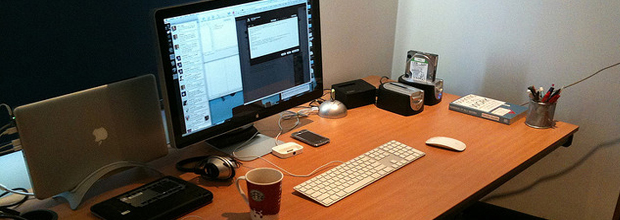Working the realm of freelancing at times can provide a very rough work environment. Long hours in front of the computer, constant e-mail floods, and phone calls from clients all day will tire even Superman. With so much going on it’s all too easy losing focus and becoming distracted.
It’s for these major reasons that your average freelancer finds it difficult to balance their workday. Spending some time listing out your tasks and providing a brief schedule will dramatically influence the flow of your work sessions.

Below I’ve gone into an investigation towards some of the key points in a freelance worker’s average day. These ideas should help newbies in the field to adapt and provide a blueprint for their own time schedule. Granted there are a lot of freelance designers and developers today, so the process of working has been split.
Incremental Focus
When sitting down to begin working mindset will be the true patron over all. If you’re going in to work with a poor mindset you’ll often have a difficult time focusing. This may not be the case with some projects, however if you find yourself working countless hours at a time it’s healthy to slow down and provide break points for yourself.
Ideally writing or digitally creating a fixed time schedule will help you blend into the mold without too much resistance. Whenever you’re changing the natural flow things will seem awkward at first. By having an alarm or Master Tasks List you have something physical to place attention towards. This will stop you from tiring away for so many hours and draining creative thought.

Staring at a computer screen for more than a few hours at a time will often result in depression and deflated moods. It’s good to stretch and move around the room every 30-60 minutes to keep blood flowing. In this way project work will seem effortless and much less stressful if you plan enough increments of working time.
Experiments with Working Hours
Many freelancers from around the globe have recognized the freedom provided with remote project work. Whether working as a digital artist, writer, web designer, or programmer the same concepts are applied. Wherever you have a computer and Internet access is potentially your own mobile office space.

Try setting yourself up for differing schedules and figure out which times of day you enjoy working. Each of us will hold a different opinion and have limitations based on external variables, such as family and social activities. I often find younger freelancers with an active night life tend to work during the later afternoon and evening hours while sleeping in late.
However if you find yourself naturally waking up early there’s nothing better than starting off your day with the sunrise. Many creative energies are flowing at this time and as artists we’re very receptive to this atmosphere.

As a recommendation I’d suggest planning a week ahead for a few days of testing. Purposefully shift your schedule and experiment with the many different working times. Finding the right fit for yourself will not only affect your mood but also certainly improve the quality of your project work.
Approve Time Blocks for Clients
When you’ve got some time set aside for phone calls and IM chats it makes getting work done ten times easier. With so many interruptions all day long it’s no surprise we find ourselves stressed and multitasking constantly.
If you feel comfortable set your IM status idle or busy during work hours. This will inform your clients that you are indeed online but unable to hold a conversation at that moment. This may save you the aggravation from a few phone calls as well. However when building a professional network of clients it’s best to let them know up front about your contact hours.

You should also plan this into your day at times where you feel a natural break. I know many freelancers who choose to break for the day around 2 or 3 in the afternoon. This provides them plenty of cool-down time to relax and take care of slightly extraneous activities. These could include e-mail messages or even taking phone calls from potential or past clients.
Record Important Tasks
If you have a difficult time with procrastination this is likely caused from overwhelming projects. If you find yourself struggling with creativity in design and writing, a simple shift in your awareness and schedule times can often be a quick fix.
Spend a few minutes writing down each task you must accomplish. This means going into detail where instead of just “create a Photoshop mockup” explain which bits and pieces you’ll need. Bookmark inspirational galleries and icons for later use. Using an online service will save you loads of time and keep things organized.

If you number each task based on importance this gives your mind some categorization to build off. In this way it’s much easier knowing which project to tackle first and how to handle the rest of your day come late afternoon. Whether written physically on paper or stored digitally online it’s a simple process to add new tasks and update current ones.
Conclusion
These simple tips have come out of the time I’ve spent investigating the unique schedules of freelance workers. Graphic designers and Webmasters alike find themselves facing very similar challenges. As you begin to freelance professionally the burden of financial and legal business sense seems to fall on your head.
If you apply even one of these concepts into your workday I’m sure you’ll begin to notice the benefits within a few days. Change never comes easily and it requires a bit of trudging along to see any results. But working independently provides some of the best opportunities for growth and keeps you out of the 9-5 office lifestyle.
Related Topics
Top